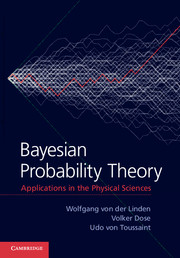Book contents
- Frontmatter
- Contents
- Preface
- PART I INTRODUCTION
- PART II ASSIGNING PROBABILITIES
- PART III PARAMETER ESTIMATION
- PART IV TESTING HYPOTHESES
- PART V REAL-WORLD APPLICATIONS
- 21 Regression
- 22 Consistent inference on inconsistent data
- 23 Unrecognized signal contributions
- 24 Change point problems
- 25 Function estimation
- 26 Integral equations
- 27 Model selection
- 28 Bayesian experimental design
- PART VI PROBABILISTIC NUMERICAL TECHNIQUES
- Appendix A Mathematical compendium
- Appendix B Selected proofs and derivations
- Appendix C Symbols and notation
- References
- Index
28 - Bayesian experimental design
from PART V - REAL-WORLD APPLICATIONS
Published online by Cambridge University Press: 05 July 2014
- Frontmatter
- Contents
- Preface
- PART I INTRODUCTION
- PART II ASSIGNING PROBABILITIES
- PART III PARAMETER ESTIMATION
- PART IV TESTING HYPOTHESES
- PART V REAL-WORLD APPLICATIONS
- 21 Regression
- 22 Consistent inference on inconsistent data
- 23 Unrecognized signal contributions
- 24 Change point problems
- 25 Function estimation
- 26 Integral equations
- 27 Model selection
- 28 Bayesian experimental design
- PART VI PROBABILISTIC NUMERICAL TECHNIQUES
- Appendix A Mathematical compendium
- Appendix B Selected proofs and derivations
- Appendix C Symbols and notation
- References
- Index
Summary
The previous examples on parameter estimation and model comparison have demonstrated the benefits of Bayesian probability theory for quantitative inference based on prior knowledge and measured data. However, Bayesian probability theory is not a magic black box capable of compensating for badly designed experiments. Information absent in the data cannot be revealed by any kind of data analysis. This immediately raises the question of how the information provided by a measurement can be quantified and, in a next step, how to optimize experiments to maximize the information gain. Here one of the very recent areas of applied Bayesian data analysis is entered: Bayesian experimental design is an increasingly important topic driven by progress in computer power and algorithmic improvements [132, 214]. So far it has been implicitly assumed that there is little choice in the actual execution of the experiment, in other words, the data to be analysed were assumed to be given. While this is the most widespread use of data analysis, the active selection of data holds great promise to improve the measurement process. There are several scenarios in which an active selection of the data to be collected or evaluated is obviously very advantageous, for example:
• Expensive and/or time-consuming measurements, thus one wants to know where to look next to learn as much as possible – or when to stop performing further experiments.
- Type
- Chapter
- Information
- Bayesian Probability TheoryApplications in the Physical Sciences, pp. 491 - 506Publisher: Cambridge University PressPrint publication year: 2014

